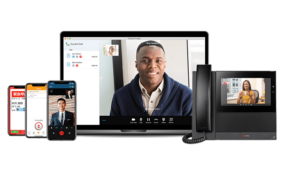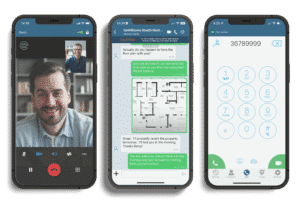
I work in a creative industry and creativity definitely benefits from getting people together in a room to properly convey the energy around their ideas and get into the weeds to workshop them. Our work is to connect our clients more closely to their consumers, to create deeply personal human experiences, and so that human connection in the conception of those ideas and in selling them to a client are definitely more robust when you’re in-person.
And then it’s those impromptu interactions in the day-to-day, those chances you get to actually check in on someone and see how they’re doing, to bounce an idea off of someone, to have serendipitous experiences that remind you why you work somewhere and why you’re so connected to the mission of the company.
We are living in a new world in which offices are becoming obsolete. How can teams effectively communicate if they are never together? Zoom and Slack are excellent tools, but they don’t replicate all the advantages of being together. What strategies, tools and techniques work to be a highly effective communicator, even if you are not in the same space?
In this interview series, we are interviewing business leaders who share the strategies, tools and techniques they use to effectively and efficiently communicate with their team who may be spread out across the world. As a part of this series, I had the pleasure of interviewingRo Kalonaros.
Ro brings Omnicom’s culture to life across the global holding company and leads content for OMC Hive, Omnicom’s internal knowledge-sharing platform, designed to provide key business and cultural intelligence for 200+ agencies and 70,000+ employees within the Omnicom Global network. You can hear from Ro as a cohost on Adweek’s newest podcast, Marketer Momentum, and at conferences and events as a speaker on topics like workplace culture, mentorship, and more. She is a triathlete, bookworm, and former punk rocker. Ask her about olive oil.
Thank you so much for joining us in this interview series! Before we dive in, our readers would love to “get to know you” a bit better. Can you tell us a bit about your ‘backstory’ and how you got started?
Igraduated college and dove headfirst into the publishing industry as it was going through massive transformation. As part of a scrappy digital editorial team during the advent of social media, I had my hands in stories from beginning to end, from writing to editing to video production to social. When the magazine was sold, I took my social skills to the startup world, where I learned how to manage global teams and think like an entrepreneur. I left to get an informal education in advertising and marketing at Omnicom, working at the global holding company level, first in bringing innovation to our agencies, and now by building culture and experience for the network.
Can you share the most interesting story that happened to you since you began your career?
I used to moonlight as the lead singer of a surf punk band. About a year ago, I got a message from the drummer of the band saying, “I think I’m getting work emails from you…” Turns out she started working as a producer at one of our agencies! I continue to marvel at how small the world really is. A person from one area of your life can appear in another area in the blink of an eye, which speaks to the need to be really deliberate about your relationships.
Can you please give us your favorite “Life Lesson Quote”? Can you share how that was relevant to you in your life?
I always come back to this Italian proverb: “When the game is over, the king and the pawn go back in the same box.”
Where I sit in my company, I have to interface with employees at every level and from every discipline. I look to learn from the most junior folks just as much as I look to learn from the C-suite. I treat everyone I meet with the same level of respect. There is no room for ego if you want to grow and get better and smarter. You should never feel like you are above anyone, because you’ll only limit yourself.
None of us are able to achieve success without some help along the way. Is there a particular person who you are grateful towards who helped get you to where you are? Can you share a story about that?
I’m endlessly grateful to my boss, Peter Sherman. In my previous position, I worked with him on a few projects and he was kind enough to keep in touch and check in after, whether it was work-related or chatting about music. When it was time for him to extend his team, he saw my value and pulled me up to join. I am beyond grateful that he not only champions my ideas, but gives me the floor to present them.
Ok wonderful. Let’s now shift to the main focus of our interview. The pandemic has changed so many things about the way we behave. One of them of course, is how we work and how we communicate in our work. Many teams have started working remotely. Working remotely can be very different than working with a team that is in front of you. This provides great opportunity but it can also create unique challenges. To begin, can you articulate for our readers a few of the main benefits of having a team physically together?
I work in a creative industry and creativity definitely benefits from getting people together in a room to properly convey the energy around their ideas and get into the weeds to workshop them. Our work is to connect our clients more closely to their consumers, to create deeply personal human experiences, and so that human connection in the conception of those ideas and in selling them to a client are definitely more robust when you’re in-person.
And then it’s those impromptu interactions in the day-to-day, those chances you get to actually check in on someone and see how they’re doing, to bounce an idea off of someone, to have serendipitous experiences that remind you why you work somewhere and why you’re so connected to the mission of the company.
On the flip side, can you articulate for our readers a few of the main challenges that arise when a team is not in the same space?
Culture suffers in a completely remote working environment. You have to remember, most of our teams have had a working relationship and built up trust and camaraderie through shared experience in a physical environment. For new folks on a team, it’s difficult to adjust into that and build the same level of relationships and access to information.
In a remote world, people also become siloed. It’s important for people to understand how their team and their department fits into the larger structure and mission of the organization, and in a remote working environment it’s easy to forget other departments even exist. In the days of the office, you could chat with Dan from L&D about what he was working on and float an idea on a training module your team would find useful. Now you have to actively seek those opportunities out.
Fantastic. Here is the main question of our interview. Based on your experience, what can one do to address or redress each of those challenges? What are your “5 Things You Need To Know To Communicate With Your Team Effectively Even If You Are Rarely In The Same Physical Space ? (Please share a story or example for each.)
- Be deliberate about creating shared human experiences: Take a class or attend a virtual event with your team. Celebrate accomplishments together. Create something as a collective. This is the best way to replicate those bonds you make in the physical world.
- Be purposeful with communication: We have to democratize access to information and be extremely thoughtful about how we communicate and the cadence of that communication. Junior employees, women, and people of color are often left out of important conversations, so be diligent about being inclusive in your communications. When you email after hours and it’s not urgent, include “For tomorrow” or “No response needed” in the subject line.
- Make culture the responsibility of every single employee: Culture is as much bottom-up as it is top-down. The more people invest and contribute, the more they feel connected to their work and their teammates.
- Connect your communications outlets: When your communications are disparate it becomes overwhelming and difficult to track. Things start to slip through the cracks. Create frameworks and templates for your communication processes. What gets sent over email vs. instant message? Where are files accessed and how are they organized? Make sure it connects in a way that is intuitive and accessible to all team members.
- Listen: Ask people how they absorb information best. Understand what processes work for them. Dig into what motivates them and what excites them. This is how you will take your team from good to great. Make your team’s day-to-day easier so they can focus on doing their best work.
One way we’re bringing all of this to life is through our internal knowledge-sharing platform. Through this platform, we are able to share case studies, research, and resources across teams; recognize our employees for their work and accomplishments; and celebrate our purpose and diversity. It allows our people to both give and take in a really meaningful way that connects them to their colleagues and the vision of the company. People are eager to contribute and learn.
Has your company experienced communication challenges with your workforce working from home during the pandemic? For example, does your company allow employees to use their own cell phones or do they use the company’s phone lines for work? Can you share any other issues that came up?
We were fortunate to have already been in the process of adopting Microsoft Teams when COVID-19 hit, but it had to be fast-tracked. The biggest challenge was getting everyone educated on how to most effectively use it, especially as new features continue to roll out every day. What we found most helpful was creating frameworks and templates we could lift and tweak from team to team.
Let’s zoom in a bit. Many tools have been developed to help teams coordinate and communicate with each other. In your personal experiences which tools have been most effective in helping to replicate the benefits of being together in the same space?
Microsoft Teams has been the most helpful because of how integrated all of the functionality is. You can go from chatting to video conferencing to collaboratively working on a document seamlessly. Quirky additions like the ability to have a meeting in a fishbowl add a little lightness and levity to a more informal meeting. While features like whiteboard have a long way to go, they’re definitely useful.
If you could design the perfect communication feature or system to help your business, what would it be?
The ability to project ourselves into a meeting room via a hologram Star Wars-style!
My particular expertise and interest is in Unified Communications. Has the pandemic changed the need or appeal for unified communications technology requirements? Can you explain?
I just went on and on about Microsoft Teams, so I fully agree with the need for unified communications technology. What’s been even more powerful is the ability to integrate our own proprietary knowledge-sharing platform into Microsoft Teams. It’s been a game-changer to join these two technologies to create something custom to our organization.
The technology is rapidly evolving and new tools like VR, AR, and Mixed Reality are being developed to help bring remote teams together in a shared virtual space. Is there any technology coming down the pipeline that excites you?
I could definitely see VR/AR/MR being useful. It won’t solve the challenge of those impromptu moments, but I can see it being extremely useful for global teams to build camaraderie so that when they are finally all in the same room in a physical world, they can really hit the ground running.
Is there a part of this future vision that concerns you? Can you explain?
We are humans. We need physical interaction and human experiences. We need to find the correct balance between physical and virtual — I don’t see it as being one or the other, but a really purposeful combination of the two. There need to be safeguards in place to combat the always-on nature of remote working. Burnout is very real right now and mental health is more at risk than ever. As we approach the future of work, we need to build with these tensions at the forefront.
So far we have discussed communication within a team. How has the pandemic changed the way you interact and engage your customers? How much of your interactions have moved to digital such as chatbots, messaging apps, phone, or video calls?
Our customers are huge global corporations and brands. Some of them are already asking us to meet in person again. It goes back to that camaraderie and trust and the presentation of creative ideas. Connections are created with emotion and empathy, both of which are much stronger in a physical setting. That being said, we have found creative ways to engage over video! It’s forced us to think outside the box and find new ways to communicate our personality and unique value.
In my experience, one of the trickiest parts of working with a remote team is giving honest feedback, in a way that doesn’t come across as too harsh. If someone is in front of you much of the nuance can be picked up in facial expressions and body language. But not when someone is remote. Can you give a few suggestions about how to best give constructive criticism to a remote team member?
Always give this feedback with the video on. Try to limit distractions as much as possible so you can give your full focus to this person. And start the conversation with empathy. Really inquire about what is going on with that person and how they’re doing. Ask about their challenges and frustrations and then try to tailor your feedback as solutions to those challenges and frustrations.
Can you give any specific ideas about how to create a sense of camaraderie and team cohesion when you are not physically together?
Have more fun. Find opportunities for playfulness in your meetings. Start with a game or a song. When people present, encourage them to make it interactive and find ways for the audience to participate. It’s easy to tune out when you’re not actively engaging, even when you genuinely want to focus, so involving everyone keeps people present and makes the experience much richer.
Schedule 5 or 10-minute check-ins that function as ‘water cooler’ conversations. Ask what’s inspiring someone or what’s exciting them, both in and out of work. Find out what they did over the weekend. These moments create trust and empathy.
Ok wonderful. We are nearly done. Here is our last “meaty” question. You are a person of great influence. If you could inspire a movement that would bring the most amount of good to the most amount of people, what would that be? You never know what your idea can trigger. 🙂
Find someone who has the same passion as you but is different in every other way and mentor them. Give a shot to someone who may have been overlooked. Really listen to them. It’s an opportunity for both of you to expand and grow.
How can our readers further follow your work online?
You can follow me on Twitter, Instagram, and LinkedIn! I love when people start conversations in the comments.
Thank you so much for the time you spent doing this interview. This was very inspirational, and we wish you continued success.
About The Interviewer: David Liu is the founder and CEO of Deltapath, an award-winning unified communications company that liberates organizations from the barriers of effective communication. Liu is known for his visionary leadership, organic growth strategies, and future-forward technology. Liu is highly committed to achieving a greater purpose with technology. Liu’s business insights are regularly featured in Forbes, Entrepreneur Magazine, Tech Crunch, and more.



